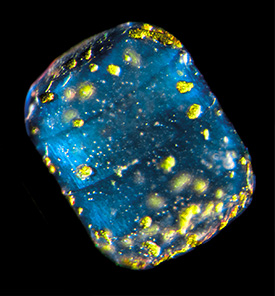A cell-wall in glass supports photosynthesis of microalgae
Diatoms are microscopic algae that live in all oceans, lakes and rivers on Earth. They use sunlight to produce oxygen and biomass – a process known as photosynthesis. Diatoms build a remarkable nano-porous cell-wall made of pure glass around them. A team of researchers from the University of Copenhagen could now show that these minute cell-wall structures interact with sunlight to make diatom photosynthesis more efficient.

A nano-porous cell-wall of glass enhances blue light inside the microscopic diatom cell and efficiently distributes light over the whole cell volume containing yellow-brown chloroplasts, wherein photosynthesis takes place. In: Plankton. Wonders of the drifting world (credit: Christian Sardet; www.planktonchronicles.com).
Photosynthesis is one of the most important biochemical processes on Earth, providing light-driven primary production of new biomass and molecular oxygen as a byproduct. Only plants, algae, and some bacteria are able to perform photosynthesis. Diatoms are microalgae that contribute about 25% of global photosynthesis, and they are thereby the main primary food-source for many organisms in the oceans. A unique feature of diatoms is a cell-wall made of glass perforatet by minuscule nanoporous structures - so minute that they interact with the photons of incoming sunlight. In a new study published in the leading plant science journal New Phytologist, a team of researchers at University of Copenhagen (Denmark) led by Professor Michael Kühl describe how the diatom cell-wall interacts with sunlight to optimize photosynthesis of these microalgae.
Highly ordered structures made of glass
– „It is fascinating that diatoms can build such small structures at cold water temperatures, while humans need high temperatures to fabricate glass“, says Johannes Goessling, former PhD student in Prof. Kühl‘s group. Diatoms use specific enzymes to precipitate glass from water, but how and why they coordinate the formation of such highly ordered glassy structures is still debated. Johannes Goessling continues: „Many groups had investigated dry cell walls of diatoms, but we decided to focus on studying the cell wall and intact living diatoms under their natural fully immersed condition“.

The structure of diatom cell-wall can be regarded as a biological photonic crystal – that is, a highly ordered, periodic structure with dimensions matching the wavelengths of sunlight, which can guide light. The group found that the periodic nano-porous structures in the diatom cell wall guide light for homogenous exposure of the cell´s chloroplasts, i.e., the organelles where photosynthesis takes place. Moreover, the glass structures enrich more energetic blue light inside the cell, supporting higher rates of photosynthesis.
New methodology
To demonstrate the importance of the diatom cell wall optical properties, the group had to develop novel means of measuring light and photosynthesis at the single cell level. Michael Kühl explains: „We developed a new microscopic setup that made it possible to focus a laser beam of defined color down to a tiny (10 µm wide) spot that could be projected onto a small part of a single living diatom cell, while the photosynthetic activity of the whole cell was mapped on a microscope. Using tiny fiber-optic light microsensors, we also measured light at one side of a single diatom while illuminating it with the small spot on the other side of the cell.“ When using these novel tools, the researchers could demonstrate that light was distributed from the incident light spot over the whole glass shell and thereby stimulated photosynthetic activity all over the cell despite the very local illumination. There are more than 10,000 diatom species, all of which vary in their cell-wall structure, and the researchers hypothesize that such variation could help different diatoms optimize light harvesting under various light conditions.
Learning from nature
Michael Kühl continues: „Similar nano structures are surprisingly widespread in plants and algae, but only few examples have been directly linked to a role for photosynthetic efficiency. Giant clams, for example, use layered photonic structures in their tissue to reflect light that can harm their photosynthetic symbionts, while at the same time redirecting beneficial wavelengths into the tissue for optimal exposure of their symbionts. Begonia plants from tropical rainforests as well as some moss plants also have highly organized photonic structures inside their leaves, apparently helping them to capture light in shaded habitats.“ Johannes Goessling concludes: „With our new methodology, we are now in a good position to further investigate such biological structures with regard to their potential implications for solar energy utilization. Besides giving fascinating insights to how structure-based optics and physiology interact in natural systems and organisms, such studies can also inspire innovation and future design of more efficient light energy-harvesting technologies and materials.”
The work was supported by a Sapere-Aude Advanced grant from the Independent Research Fund Denmark, as well as infrastructure and a postdoctoral fellowship grants from the Carlsberg Foundation.
Contact
Professor Michael Kühl
Marine Biological Section
Department of Biology
University of Copenhagen
Phone (+45) 40 47 63 04
Email: mkuhl@bio.ku.dk
Postdoc Johannes W. Goessling
Département des Sciences de la Vie
Université de Nantes, France
Phone (+33) 75 34 28 21 2
Email: johannes.goessling@univ-nantes.fr
